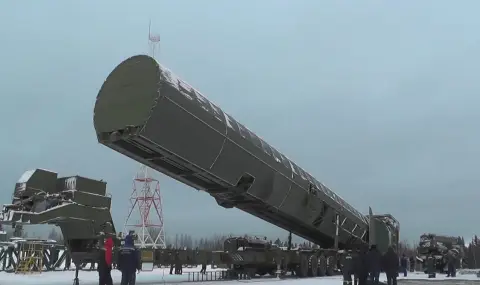U.S. administration sources do not confirm that the missile fired was intercontinental. The BBC and its US partner CBS spoke to two US officials about whether Russia did indeed use an ICBM against Ukraine.
Ukrainian officials announced the launch of an intercontinental ballistic missile over the city of Dnipro. President Volodymyr Zelensky said this conclusion was based on the observed characteristics of the missile, but the investigation was still ongoing. Moscow did not comment on these statements.
Both administration officials agreed to speak on condition of anonymity. According to them, the missile is indeed ballistic, but not intercontinental. One of the interlocutors said that this is a medium-range missile.
Russian Foreign Ministry official Maria Zakharova received a call during a press briefing and was asked not to comment on the ICBM statements.
If the information from the phone conversation between Maria Zakharova and her unknown interlocutor can be considered true, the Russian missile was aimed at the "Yuzhmash" plant. in Dnipro, which produces rocket engines for civilian and military purposes, as well as repairs military equipment.
Until now, the missile in question has not been used in combat and its characteristics are largely unknown. It is known that it can also carry nuclear warheads and is based on the two-stage "Topol-M".
According to Defense Express, "Rubezh" The RS-26 is a development of the Russian Federation with a high degree of secrecy, as it was made in violation of the Treaty on Intermediate and Short-Range Missiles. Its development started back in 2006, but in 2018 the missile has been phased out of the weapons program until 2027. It was believed that the Russian Federation focused on the development of the "Iskander-K" instead. In July of this year, the Kremlin threatened to resume the production of medium-range missiles, among which the "Rubezh" falls.
Among these features, which are quite likely, are a launch mass of 40-50 tons, a range of up to 6000 km and equipment in the form of four separate warheads of 0.3 Mt capacity each, similar to those used in the RS -24 Yars. It is also believed that it may be equipped with a "Vanguard" type hypersonic planning unit.
The BBC military observer commented that it is generally accepted that intercontinental ballistic missiles (ICBMs) have a range of at least 5,500 kilometers and are capable of attacking targets on another continent. But according to him, this classification is quite conditional - it was adopted in order to eliminate inconsistencies in the negotiations on the reduction of strategic offensive weapons and bring their characteristics to a certain common indicator.
The RS-26 "Rubezh" missile, which according to Ukrainian sources was used to strike the Dnipro, has a range of 2,000 to 6,000 kilometers, according to discovered data. This range usually applies to medium-range missiles (IRMs).
Perhaps the declared maximum flight range of the RS-26 - 6000 km allowed the Russian side to avoid accusations of violating the Treaty on the Elimination of Intermediate-Range Missiles (IMF), which was signed by the USSR and the USA in 1987 . and was still in force at the time of development of the new missile system in force. Formally, based on their maximum range, these missiles can be classified as ICBMs, which are not subject to the INF Treaty.
However, intercontinental or not - the classification of the missile that was launched against Ukraine is not so important.
Medium-range missiles have no less destructive power than ICBMs. They have the same ballistic and high-velocity characteristics, can carry no less payload, including a nuclear payload, and also have multiple warheads. And their shorter range makes them even harder to take down - missile defenses have less time to react.
If it is confirmed that the strike on the Dnipro was actually carried out by the RS-26 "Rubezh" or something similar, the very fact of the use of strategic weapons (albeit in a non-nuclear version) in the hostilities in Ukraine is already raising the stakes.
In itself, the use of such expensive and difficult-to-produce missiles to attack Ukrainian cities can hardly be considered justified even from a military point of view. But the fact that it happened after Kiev's allies allowed Western weapons to be used to attack Russian territory appears to be a demonstration of Moscow's willingness to play with higher stakes and further escalation of the conflict.
